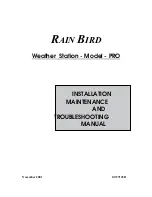
Page 3
2. On a Vantage Pro console, press UV to see the UV sensor reading if you are install-
ing a UV sensor. If you are installing a Solar Radiation Sensor, press 2ND then
SOLAR to see the Solar Radiation reading.
On a Vantage Pro2 console, press 2ND then UV to see the UV sensor reading and
2ND then SOLAR to see the Solar Radiation Reading.
3. Shade the sensor with your hand. The value should drop. A zero is a possible read-
ing; however, if you see dashes, wait a minute for a reading to come in. If you still
see no reading, reconnect the sensor cable to the ISS, ensuring it is in the proper
receptacle. If you still see no reading, contact Davis Technical Support (see
Techni-
cal Support
at the back of this manual).
4. Unplug the sensor cable from the SIM.
For permanent mounting, unplug the cable from the ISS
and follow the instructions below. The test procedure is
complete.
Securing the Sensor on the Shelf
1. Remove the rain collector cone from the ISS: turn it
counterclockwise until the latches allow you to lift it up
and off.
2. Place the sensor shield onto the sensor body as shown
here.
3. Route the sensor cable down through
one of the large holes in the mounting
shelf.
4. Place a flat washer over the end of each
screw and insert it through the shield
and body.
5. Place a spring over the end of each
screw and hold the springs in place
using a #6 screw retainer.
6. Secure the sensor to the mounting shelf
by driving the screws into the appropri-
ate holes as shown.
7. Using the bubble level on the sensor as a
guide, adjust the sensor until it is level
by tightening or loosening the screws.
8. Repeat the above process to install an
additional sensor. Replace the rain collector cone when finished.
Note:
Final leveling of the sensor(s) should be done with the ISS mounted in its operating location.
Routing the Sensor Cable
Route the sensor cable to the SIM Box and insert the cable jack into its appropriate
receptacle, marked SUN for a Solar Radiation Sensor or UV for a UV Sensor. Ensure
that the cables are free of crimps and are dressed so that they will not fray in the wind.






















